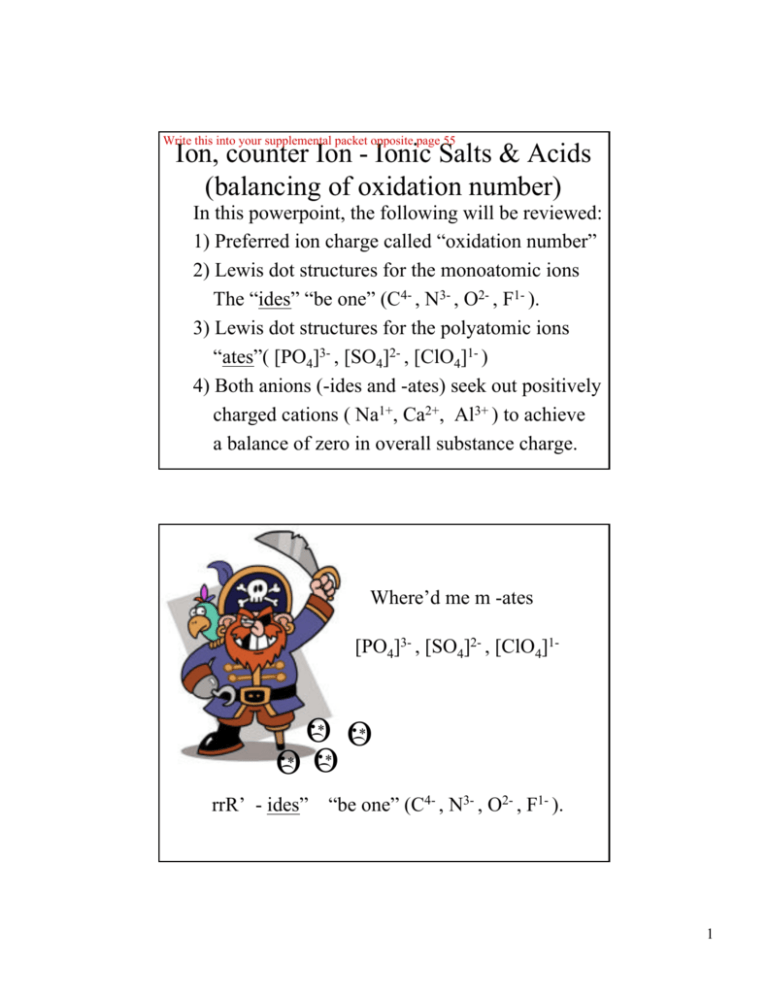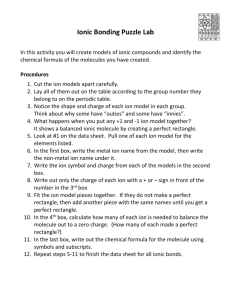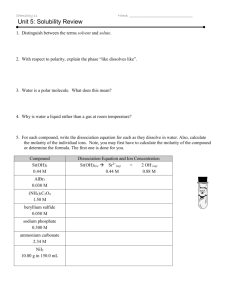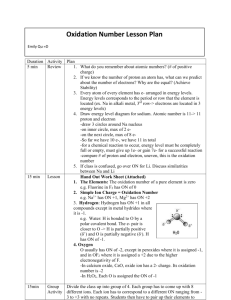pdf.format
advertisement

Write this into your supplemental packet opposite page 55 Ion, counter Ion - Ionic Salts & Acids (balancing of oxidation number) In this powerpoint, the following will be reviewed: 1) Preferred ion charge called “oxidation number” 2) Lewis dot structures for the monoatomic ions The “ides” “be one” (C4- , N3- , O2- , F1- ). 3) Lewis dot structures for the polyatomic ions “ates”( [PO4]3- , [SO4]2- , [ClO4]1- ) 4) Both anions (-ides and -ates) seek out positively charged cations ( Na1+, Ca2+, Al3+ ) to achieve a balance of zero in overall substance charge. Where’d me m -ates [PO4]3- , [SO4]2- , [ClO4]1- rrR’ - ides” ) ) ) ) •* •* O O •* •* O O “be one” (C4- , N3- , O2- , F1- ). 1 Things to keep in mind when considering oxidation numbers: o o o o 1) Any atom in its elemental form [Na(s), O2(g) Mg(s), Cl2(g)] has an oxidation number of zero 2) For monatomic ions, the oxidation number equals an ion’s charge; 4- C N 3- 2- 1- O F fluoride ion carbide ion nitride ion oxide ion 3) For polyatomic ions, the sum of the constituent atoms’ oxidation numbers is equal to the charge of the ion; PO43- SO42- ClO41- phosphate ion sulfate ion perchlorate ion 4) For neutral compounds, the sum of the constituent oxidation numbers is equal to zero. Lewis dot structures for monatomics 4- C carbide ion 4- C N 3- nitride ion 3- N •• F •• •• •• •• •• •• O •• 2- 2- 1- •• 3- •• N •• •• •• •• •• C •• 4- 1- O F oxide ion fluoride ion 2- O 1- F monatomics 2 2- SO4 •• •• •• •• •• •• •• •• •• •• •• •• •• •• PO4 •• sulfate ion 3- •• •• •• phosphate ion SO4 •• 3- 1- O •• O Cl •• O O •• •• •• •• •• •• •• PO4 O •• O S •• O O •• •• •• O •• O P •• O O 2- •• Lewis dot structures for polyatomics 3- ClO41- perchlorate ion 2- 1ClO4 oxyanions Balancing oxidation numbers in ionic salts “Two atoms are walkng down the street….”(yes, we get the joke, DrG) Draw a visual picture for the structure of sodium fluoride, NaF 1+ Na 1- F Draw a visual picture for the structure of calcium fluoride,CaF2 1- F 2+ Ca 1- F 3 Balancing oxidation numbers in ionic salts Draw a visual picture for the structure of aluminum fluoride, AlF3 1- F 3+ Al 1- 1- F F Balancing oxidation numbers in ionic salts Draw a visual picture for the structure of aluminum oxide, Al2O3 2- O 23+ Al 3+ 2- Al O O 4 Balancing oxidation numbers in ionic salts Can chemists have BO???????? No way, chemists have B2O3 Draw a visual picture for the structure of boron oxide, B2O3 2- O 23+ 3+ 2- B B O O Balancing oxidation numbers in ionic salts Draw a visual picture for the structure of magnesium oxide, MgO 2+ Mg 2- O 5 Balancing oxidation numbers in ionic salts Draw a visual picture for the structure of sodium phosphate, Na3PO4 1+ Na 1+ Na 3- PO4 1+ Na Balancing oxidation numbers in ionic salts Draw a visual picture for the structure of sodium sulfate, Na2SO4 2- 1+ Na SO4 Na 1+ 6 Balancing oxidation numbers in ionic salts Draw a visual picture for the structure of sodium perchlorate, NaClO4 1+ Na 1- ClO4 Balancing oxidation numbers in ionic salts Does DrG feed his dog AlPO? No way, I feed him AlPO4 Draw a visual picture for the structure of aluminum phosphate, AlPO4 3+ Al 3- PO4 7 Balancing oxidation numbers in Transition Metal ionic salts Draw a visual picture for the structure of iron (II) phosphate, Fe3(PO4)2 2+ Fe 3- PO4 2+ Fe 3- PO4 2+ Fe Note, transition metal ionic salt names….. Always use a roman numeral in its compound name To represent the oxidation number for the TM ion Balancing oxidation numbers in ionic salts Draw a visual picture for the structure of iron (III) phosphate, FePO4 3+ Fe 3- PO4 Note, transition metal ionic salt names….. Always use a roman numeral in its compound name To represent the oxidation number for the TM ion 8 The acid proton, no electrons, no neutrons, JUST a proton Draw a visual picture for the structure of a PROTON, H+ 1+ H Note, a substance with hydrogen listed first in its chemical formula (i.e. stomach acid, HCl) is a called an acid. The acid proton, no electrons, no neutrons, JUST a proton Draw a visual picture for the structure stomach acid, HCl, 1+ H Cl 1- 9 Balancing oxidation numbers in an oxyanion acid Draw a visual picture for the structure of phosphoric acid, H3PO4 1+ H 1+ H 3- PO4 1+ H Balancing oxidation numbers in an oxyanion acid Draw a visual picture for the structure of sulfuric acid, H2SO4 2- 1+ H SO4 H 1+ 10 Balancing oxidation numbers in an oxyanion acid Draw a visual picture for the structure of perchloric acid, HClO4 1+ H 1- ClO4 Balancing oxidation numbers in an monatomic acid Draw a visual picture for the structure of hydrochloric acid, HCl 1+ H 1- Cl Note, use the word hydro if acid is a monatomic acid (i.e. stomach acid, HCl) is a called hydrochloric acid. 11 Balancing oxidation numbers in a monatomic acid Draw a visual picture for the structure of hydrosulfuric acid, H2S 1+ H S 2- 1+ H Note, use the word hydro if acid is a monatomic acid (i.e. dihydrogen sulfide, H2S) is a called hydrosulfuric acid. Balancing oxidation numbers in an monatomic acid Draw a visual picture for the structure of hydrofluoric acid, HF 1+ H F 1- 12 Other polyatomic ions carbonate ion and nitrate ion Draw a visual picture for carbonate ion, CO32- and nitrate ion, NO31- 2- 1- CO3 NO3 Balancing oxidation numbers in a base Draw a visual picture for the structure of sodium hydroxide, NaOH 1+ Na OH 1- Note, use of the word hydroxide is derived from hydro oxide “proton ion” + “oxide ion” combinded equals hydroxide ion (H1+ and O2together equals OH1-) 13 Balancing oxidation numbers in a base Draw a visual picture for the structure of calcium hydroxide,Ca(OH)2 OH 1- 2+ OH Ca 1- Note, use of the word hydroxide is derived from hydro oxide “proton ion” + “oxide ion” combinded equals hydroxide ion (H1+ and O2together equals OH1-) Balancing oxidation numbers in a hydro - ate ions Draw a visual picture for the structure of hydrogen carbonate ion, HCO31- 2- 1+ 1- CO3 H equals proton combined with carbonate ion H+ + reactant ions CO32- HCO3 hydrogen carbonate ion, HCO31– combination reaction HCO31– product ion 14 Balancing oxidation numbers in a hydro - ate ions Draw a visual picture for the of dihydrogen phosphate ion, H2PO41- 1+ H 3- 1+ H 1- PO4 equals proton combined with phosphate ion 2H+ + PO43- H2PO4 dihydrogen phosphate ion,H2PO41– H2PO41– combination reaction reactant ions product ion Supplemental packet page 75 Sparklettes Water Dr. Gergens - SD Mesa College The Crystal-Fresh® Drinking Water ingredient label says the following: “Drawn from our deep protected wells in Santa Ana, CA. Purified using our Crystal-Fresh process, including filtration, ozonation, reverse osmosis, and/or dionization. Contains purified water and specially selected minerals in nutritionally insignificant amounts for great taste (sodium bicarbonate, magnesium chloride, calcium chloride and sodium sulfate). Lets learn to write the correct formulas for these substances (sodium bicarbonate, magnesium chloride, calcium chloride and sodium sulfate) that Sparkletts ® adds to it’s purified water In “nutritionally insignificant amounts for great taste.” 15 Supplemental packet page 76 Lets learn to write the correct formulas for these substances (sodium bicarbonate, magnesium chloride, calcium chloride and sodium sulfate) that Sparkletts ® adds to it’s purified water In “nutritionally insignificant amounts for great taste.” 2- 1+ CO3 Na 1+ Na Lets learn to write the correct formulas for these substances (sodium bicarbonate, magnesium chloride, calcium chloride and sodium sulfate) that Sparkletts ® adds to it’s purified water In “nutritionally insignificant amounts for great taste.” 1- Cl 2+ Mg Cl 1- 16 Lets learn to write the correct formulas for these substances (sodium bicarbonate, magnesium chloride, calcium chloride and sodium sulfate) that Sparkletts ® adds to it’s purified water In “nutritionally insignificant amounts for great taste.” 1- Cl 2+ Cl Ca 1- Lets learn to write the correct formulas for these substances (sodium bicarbonate, magnesium chloride, calcium chloride and sodium sulfate) that Sparkletts ® adds to it’s purified water In “nutritionally insignificant amounts for great taste.” 1+ Na 2- SO4 1+ Na 17 Sparklettes Water Nomenclature Exercise: "Nutritionally insignificant amounts of these compounds added for good taste." Dr. Gergens - SD Mesa College Supplemental packet page 76 + – 1. Write the name each cation and each anion (e.g., Na is sodium ion; Cl is chloride ion) 2. Say and write the name of the ionic salt compound by combining each cation with each anion in the table (e.g., sodium chloride) 3. Complete the table by writing in the ionic salt compound formula in each cell of the table (e.g., NaCl). 4. When writing a formula a cation and anion must combine in an appropriate ration to balance charge; see examples on back. cations (name these ions) – Cl chloride ion Na+ NaCl sodium ion sodium chloride Mg2+ magnesium ion Ca2+ calcium ion anions (name these ions) 2- – SO4 sulfate ion HCO3 hydrogen carbonate ion Na2SO4 NaHCO3 sodium sulfate sodium hydrogen carbonate MgCl2 MgSO4 Mg (HCO3) 2 magnesium chloride magnesium sulfate magnesium hydrogen carbonate CaCl2 CaSO4 Ca(HCO3) 2 calcium chloride calcium sulfate calcium hydrogen carbonate 5. Predict the transition metal cation charge for iron, Fe, in the ionic salt Fe 2 (SO4 )3 , and place it in the cation box below. 6. Give a name for Fe 2 (SO4 )3 . Since transition metals can variable charge, you must some how indicate metal cation charge in its name. 3+ – – 7. Write additional formulas for the cation Fe combined with the anions Cl and HCO3 and give their compound names. cation iron (III) ion FeCl3 Fe2(SO4)3 Fe(HCO3) 3 iron (III) chloride iron (III) sulfate iron (III) hydrogen carbonate Acids . In general, a substance that has an 'H' listed first in its formula is referred to as an acid. Name the acid but place a prefix in its name di = 2, tri = 3, tetra = 4, penta = 5, hexa = 6, hepta = 7, octa = 8, nona = 9, deca = 10 to indicate the number of hydrogens in the formula. anions cations H+ hydrogen ion give a common name and use for each acid – Cl 2- SO4 – HCO3 HCl H2SO4 H2CO3 hydrogen chloride hydrogen chloride dihydrogen carbonate hydrochloric acid sulfuric acid carbonic acid stomach acid car battery acid carbonated water 18









